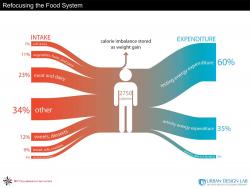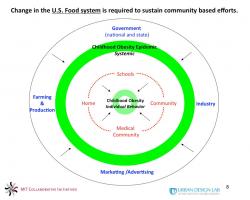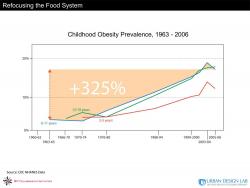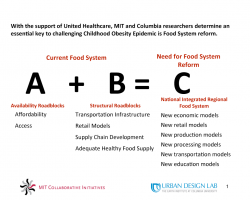Childhood Obesity
Overview
Dramatic increases in the early onset of adult medical conditions associated with childhood obesity, along with the need to contain healthcare costs, have placed obesity at the center of industry, public health, political, and medical debate. These independent fields must work together if we are to implement real change.
Utilizing a unique design approach,The Urban Design Lab in the Earth Institute at Columbia University and MIT Collaborative Initiatives, with the support of the United Health Foundation, joined forces to study a broad, system-based view of obesity. The main conclusion was that the foodsystem and health are integrally linked. To ensure that efforts to fight obesity are sustainable, we must develop a national foodsystem based on access, affordability, quality and health.
Background
The rates of childhood obesity have increased by 325% since the early 1960s, with a dramatic and steady growth since 1980. Factors that are contributing to the crisis include:
- A steady increase in the costs of healthy foods.
- The rise of fast food, as well as packaged and highly processed foods that are often high fat and low cost.
- Increase in government food subsidies that support production of low cost, ‘fast’ foods.
- An increasingly widespread and complex food system, which leads to greater production, transportation and environmental costs.
- Changes in lifestyle and urban development which are lowering the rates of physical activity, particularly in lower economic populations
- A rise in ‘food deserts’, areas with no access to grocery stores or fresh foods, in rural and urban low-income neighborhoods
- A self-perpetuating cycle that predisposes children to obesity due to prenatal conditions.
It has been shown that once a child has become obese it is extremely difficult to reverse. At this point it becomes a lifetime struggle challenging the individual and families, burdening the medical system, and driving healthcare costs to unsustainable limits.
Strategy
In September 2007, with the support of the United Health Foundation, MIT Collaborative Initiatives and the Urban Design Lab at the Earth Institute at Columbia University joined together to study Childhood Obesity through a design lens. Based on an earlier systems-based study on Stroke, the goal of the project was to take a comprehensive systems-based view of obesity at multiple scales to assess potential gaps in the methods being used to combat the dramatic rise in childhood obesity and to develop new approaches to curbing the epidemic.
Design, as a discipline, considers the interdependence of diverse specialties within a system. A design-based analysis requires knowledge of the relationship between various parts of the system; an understanding of the long-range effect of changing any one part of the system; and an awareness that approaching any one part of a comprehensive system independently will have a limited effect. To date, application of design research methods to broad social issues has been limited, but the potential value of such an approach, which considers a broad range of factors affecting an issue and determines where the pivotal intersections occur, is great.
What resulted was the identification of two major gaps in the effort to fight childhood obesity:
- A lack of coordination among intervention efforts leading to an endless cycle of “start-up” programs.
- A reluctance to take on the larger foodsystem
The team chose to target the challenge of the foodsystem as the key to mounting a sustainable national effort to change the tide of childhood obesity. Many groups around the country are working to address the issue of obesity as it affects children. From local community groups to national foundations there is a growing momentum. However, successful programs are often limited by the larger food environment. For example, a successful school program is limited by a child’s home environment or the community environment; a successful community program is limited by the surrounding retail environment. Isolated interventions are fighting an uphill battle.
A strong integrated foodsystem based on access, affordability, quality and health will support the many community interventions taking place across the country and enable long-term change. Achieving this goal will require new collaborations among industry, health, agriculture, academia, non-profit, and government domains as well as the development of new business models focused on providing a healthy food supply.






